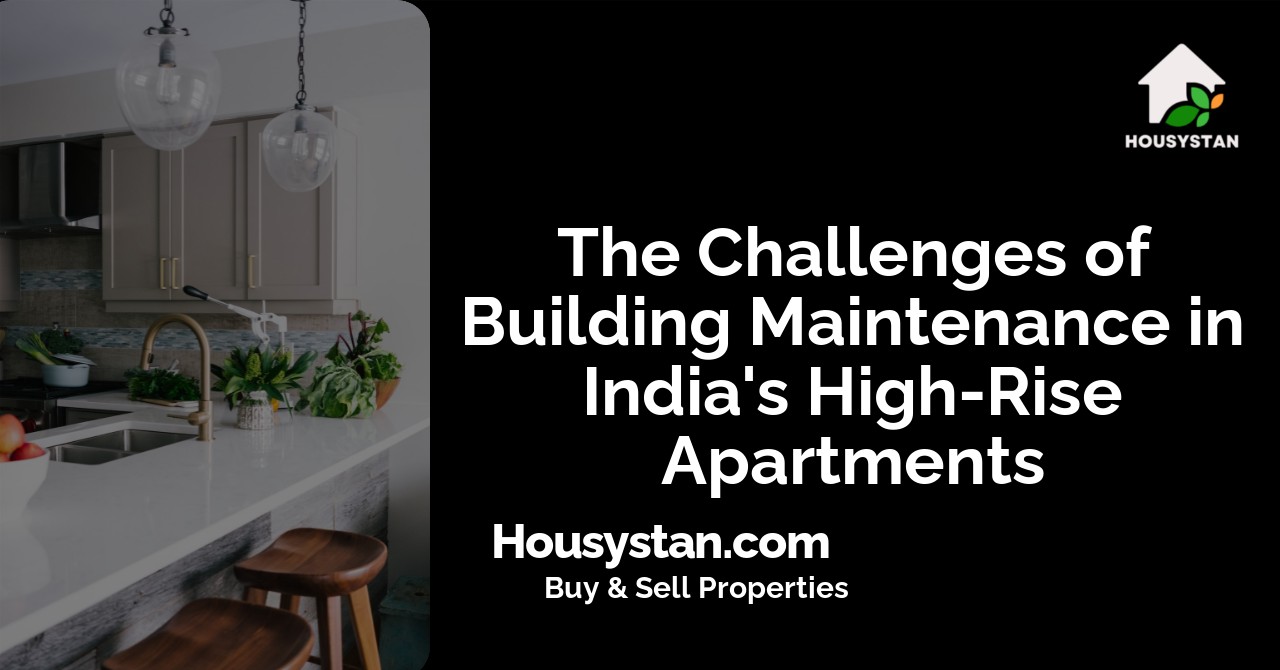The Challenges of Building Maintenance in India's High-Rise Apartments
Read latest blogs and articles from Housystan

The Information mentioned here was last updated on:
18/12/2025Navigating the Challenges of Building Maintenance in India’s High-Rise Apartments
As India rapidly ascends the architectural ladder with its sprawling high-rise apartments, maintaining these towering structures becomes increasingly complex. These skyscrapers are not only a testament to modern engineering but also pose unique challenges when it comes to maintenance. From ensuring safety to managing costs, high-rise living demands a nuanced understanding of building upkeep. This article delves into the pressing challenges of building maintenance in India's high-rises while offering insights into effective management practices.
Understanding the High-Rise Boom in India
- Verified Tenants/Buyers
- Unlimited Property Listing
- Zero subscription/charges fee
India's urban landscape is evolving rapidly, with high-rise apartments replacing traditional housing. According to the National Building Code, any building taller than 15 meters is considered a high-rise. In major cities like Mumbai, Bengaluru, and Delhi, sky-high apartments are becoming the norm, driven by urbanization and the need for space efficiency.
Key Reasons Behind the High-Rise Trend:
- Scarcity of Land: With limited land available in urban areas, vertical development allows for maximizing space.
- Population Growth: The burgeoning population in cities demands more housing, pushing developers to build upward.
- Desire for Modern Amenities: High-rises offer a range of amenities, from swimming pools to gyms, attracting buyers seeking a contemporary lifestyle.
Top Challenges in Maintaining High-Rise Apartments
1. Safety Protocols and Standards
Safety is paramount in high-rise buildings. Residents rely on management to maintain stringent safety standards, which include fire safety, elevator maintenance, and structural integrity.
- Fire Safety: High-rises must be equipped with fire alarms, extinguishers, and safe evacuation routes. Regular drills and maintenance of fire systems are mandatory to ensure resident safety.
- Elevator Maintenance: Elevators are the lifeline of any high-rise. Regular checks and prompt repairs are necessary to prevent malfunctions and ensure smooth operations.
- Structural Stability: Ensuring the building's structural integrity through regular inspections can prevent long-term damage and avoid catastrophic failures.
2. Infrastructure and Facility Management
Managing infrastructure in high-rise apartments can be a daunting task, given the complexity of facilities involved.
- Water Supply Systems: High-rise buildings require sophisticated plumbing systems to ensure consistent water supply across all floors.
- HVAC Systems: Heating, ventilation, and air conditioning systems demand regular maintenance to operate efficiently, affecting both energy consumption and residential comfort.
- Power Management: Challenges related to the distribution of electricity and maintaining backup systems in case of power cuts are prevalent.
3. Environmental Considerations
Sustainability is becoming a critical aspect of building maintenance, influencing the design and operation of high-rise apartments.
- Waste Management: Effective waste disposal systems must be in place to manage large volumes of waste generated by residents.
- Water Conservation: Implementing rainwater harvesting and water recycling systems can mitigate the strain on local resources.
- Energy Efficiency: Encouraging the use of solar panels and energy-efficient appliances can reduce the building's carbon footprint gradually.
4. Financial Challenges
Maintaining high-rise buildings involves significant financial resources, impacting the overall budget and requiring efficient fund management.
- Maintenance Costs: Routine maintenance, emergency repairs, and upgrades require a significant portion of the budget.
- Service Charges: Determining fair and manageable service charges for residents is crucial to cover maintenance costs without imposing excessive financial burden.
5. Technological Integration
Incorporating technology in building maintenance can streamline operations but also presents its own set of challenges.
- Smart Systems: Implementing smart technology for lighting, security, and utility management can improve efficiency, but requires investment and skilled management.
- Surveillance and Security: High-rise apartments need robust security systems, including CCTV, access controls, and visitor management systems.
Effective Strategies for Overcoming Maintenance Challenges
Regular Inspections and Audits
Conducting routine inspections and audits can help identify potential issues before they escalate. Having a dedicated team for timely assessments ensures that all systems are functioning correctly.
Resident Engagement and Awareness
Educating residents about maintenance practices and involving them in decision-making processes can foster a responsible community. This engagement can lead to more mindful usage of resources and common areas.
Professional Management Services
Engaging professional facility management services can offer specialized expertise, ensuring high standards of maintenance across various domains. These services can provide valuable support in areas like landscaping, cleaning, and technical management.
Leveraging Government Initiatives and Policies
Staying updated with government policies and initiatives can provide access to resources and funding for sustainable building practices. Initiatives like the Smart Cities Mission can guide housing societies toward more efficient maintenance strategies.
Cost-Effective Solutions and Innovations
Exploring cost-effective solutions and encouraging innovation can reduce maintenance expenses while enhancing quality. Solutions like energy-efficient lighting, automated systems, and green building materials contribute to sustainable living.
Conclusion
Maintaining India’s high-rise apartments requires a multifaceted approach, balancing safety, financial viability, and environmental sustainability. With urbanization driving new construction and technological advancements providing new tools, there is no shortage of challenges and opportunities for maintaining these towering edifices. By implementing strategic maintenance practices, fostering resident engagement, and leveraging government support, high-rise buildings can ensure a sustainable and safe living environment for all residents.